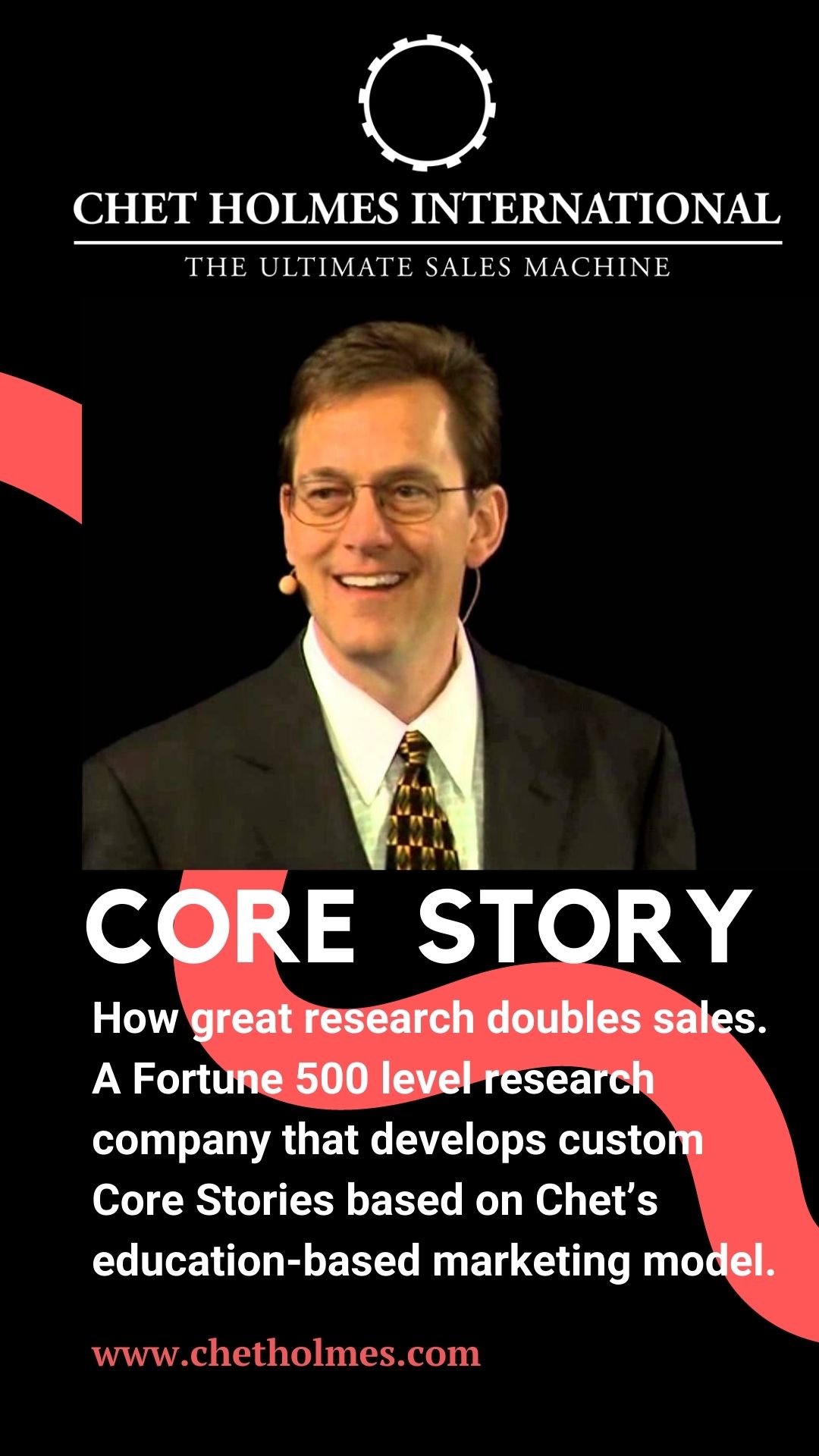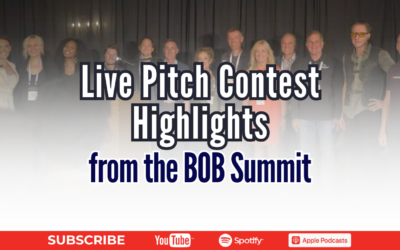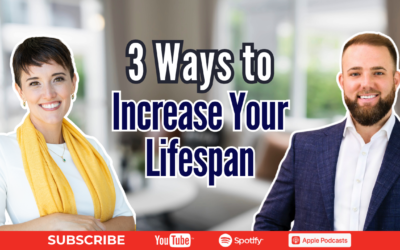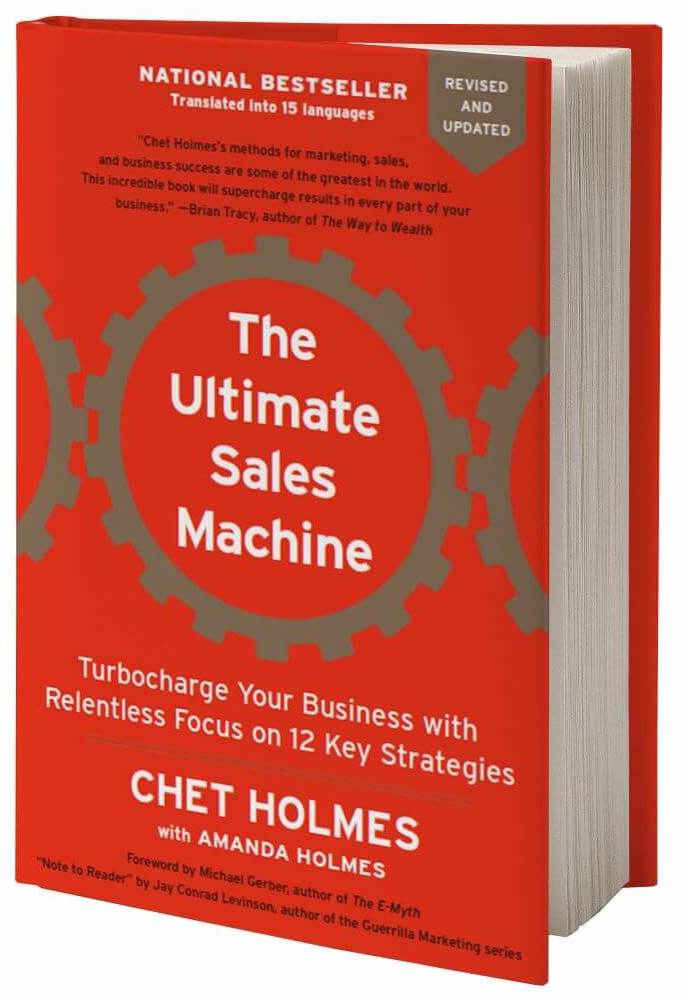Did you see the recent post by Recruiter.com?
The title was: “Apparently, the hardest thing to sell is a sales job.” 🤦♀️
It’s humorous because it’s true.
Approximately 90% of hiring managers find it more difficult to find sales talent today.
We’ve trained companies for decades on how to identify a sales superstar because it’s such a huge issue.
Most companies have a poor practice for how to hire, train, and retain top talent.
This is why 74% of sales reps fail. (Note: this data came from a survey of 650,000 reps by Objective Management Group).
So what do we need to do to find that superstar?
You’ll hear it in this week’s episode from one of our Ultimate Sales Machine Dojo sessions (our group coaching program).
You’ll discover:
-How to recognize sales superstars
-The 4 common mistakes when attracting top talent
-How to craft a compelling job ad based on a case study of a recent client
-A recent member in our dojo community that generated 101,000 views on a single LinkedIn post, what caused it and what to do with it.
You can master how to build your own team of high-performing sales superstars. Tune in now!
P.S. Interested in hiring a team of top talent? Schedule a call with us and we can help! Click here to book now.
Continued Learning: How to Hire and Retain Top Talent
- Want to know what’s keeping you from doubling your sales in the next 12 months? Take our quick QUIZ to get answers: Howtodoublesales.com
- If you’d like to have a profound breakthrough in your business, schedule your breakthrough call with a LIVE expert here: Chetholmes.com/Breakthrough
- Claim your FREE chapter 4 from the top 10 most recommended marketing and sales books of all time! Visit: Ultimatesalesmachine.com to find out how you Create 9X More Impact from every move you’re already making to win clients!
TRANSCRIPT:
*this transcript was mostly generated by AI, please excuse any mistakes 
Amanda: [00:00:00] I closed a 56 billion health insurance company from a random guy that posted on my Facebook. He posted a comment, I went into the DMs, I started saying, Hey, Who are you? It was interesting that you posted and it turned into a consulting engagement. Here is your daily dose of the ultimate sales machine coming to you from the new edition, visit ultimate sales machine.com to get your copy or multiple copies. I am your host, Amanda Holmes, CEO of Chet Holmes international. What you’re about to learn has been. Assisted a quarter of a million businesses to generate billions of dollars working faster, better, smarter. So what did we cover last week? Recognizing sales superstars, designing the perfect ad, how to screen through the hay to find that special sauce and how to interview the superstar.
So I’m going to do a little bit of recapping and then we’re going to just dive right into our breakouts and just. Find out what’s going on for everybody. I love to [00:01:00] actually find out what’s going on in your world and answer any questions and just build more of our community here for the ultimate sales machine.
So then next week we’ll talk about Dream 100, but for now we are in hiring sales superstars. So again, I wonder if any of you had epiphanies around sales superstars. What are they? I wonder if you thought about who you are and how you show up every day because sales superstars are naturally relentless.
They’re clever. They’re entertaining. They’re persuasive. They’re compelling. They’re highly communicative. They, they’re a pleasure to deal with for clients, but very often a pain to manage. Within months, they’re outselling people who have been their best for years. They perform well even when put in a bad situation with poor tools, right?
They’re learning quickly. They’re quick to innovate and improve. They succeed no matter what. And there’s really this balance, right, of ego and empathy. [00:02:00] Empathy, Very often they’ll say, I’ve never met somebody I didn’t love. You know, they just find something to appreciate in every person. And then you also need to have that ego strength too, where they’re compassionate and they can relate and they want to become friends with everybody that they meet.
But then you have to have the ego that never gives up because you have to accept that there is, in sales, right, you are gonna get rejected. Eight out of the ten times, very often, so you should have that tough skin to be able to be okay with the rejection and then keep coming back. What a superstar is, is they just get more determined the more they fail.
I’m reading a book right now, Million Dollar Weekend, by Noah Kagan. He just recently hit the bestseller list for it. And he gave a great story about how his father used to sell Xerox printers. And he wouldn’t actually, he would go after, A week he tried to get a hundred nos. ’cause if he got a hundred nos, he knew we’d get three yeses and it made him determined and [00:03:00] lean in to get those failures.
So it was a TA teaching in rejoicing in the failures. ’cause you knew that so many nos would eventually lead to a Yes. So instead of being afraid or worried about the failure, you’re leaning into it ’cause you know that it leads to the path of least resistance. Troy, you want to cover these around sales superstar, right?
We’re just recapping here.
Troy: Yeah. I just start with the end goal in mind, defining, making sure that they are someone who is driven by goals and that those goals can align with the objectives of your team. Do you want to say a little bit more about that? Because it’s shocking how often people don’t do that.
Cause you’re so good at that. Yeah, I think people get afraid to find out what the temperature range is of a specific employee or salesperson. And if you know that the top person in your level can make 80, or a million, whatever that target is, finding out what temperature rating that person can actually see themselves doing to [00:04:00] that point.
And a lot of times people are finding out they have somebody who wants to go after 70, is the high, and yet they need someone to be at 300, 000. Because that’s going to mean the type of level of revenue that’s going to actually get to the company goals. So you, you have somebody who’s so short sighted that they can’t see that far.
You’re going to have a challenge with seeing that opportunity.
Amanda: And what I love from watching you work with teams is the way that we work. Alongside one another all day, every day. And yet we don’t even know the actual personal goals in our lives. So we’ve incorporated this much more into our processes here at Ultimate sales machine, because it’s shocking if that’s supposed to be a motivator for you, whatever your personal goals are, like, you know, I want to get a home, I want to buy a boat, I want to be financially free, I want to live in two locations, whatever that may be.
Nobody actually knows what your goals are, which you should, right? [00:05:00] Troy, you want to speak to that?
Troy: Yeah, Stacey, Deja and I went through that even where we were looking at people that, you know, some people are so short sighted that they wouldn’t and then the next person is higher. I did a, I did a, A mastermind with a company customer yesterday, and it was interesting because there happened to be exactly 10 people in the room and and 3 of those people only wanted to make a quarter of what the rest of the room did, and you could see some very different alignment then that was was set up that way and 2 of the people of those 10 were the ones that had crazy high numbers.
So you can see how really. You know, the 80 20 rule applied in the room and 20 percent really do want to make 80 percent of that, that revenue and then the others were, were trickled off. So it was a really interesting exercise, but I think having that, that goal piece so that people not only have a why, but they can actually get creative and take a look at your company and the opportunity and find out a way that they can actually present themselves to you, how they could see themselves making that money and also helping you achieve your goals that you’ve laid out too.
I think having the [00:06:00] goals, both sides. And when you’re hiring, somebody is being able to say to them, our company goal is this. How do you see yourself after studying us that you could help us get to that level?
Amanda: So maybe a good takeaway for everyone on the call too. Do you know what your personal goals are that align with what your professional goals are?
And then do you know that of your coworkers? And if you don’t. You should do an exercise around this because it makes such a huge difference to know your why. Right? You get there way faster if you have a very strong why. I think we talked about all of these as well. I just wanted to dive deep on the one that you are so wonderful at.
Troy: I just real quick is to also be a person who is always looking to be a learner and a leader at the same time. Because that’s somebody who’s going to nurture your team and also be someone who can guide them. And that’s going to be really good. Someone who is consultative and has a follow up process that they insist on, it’s going to be huge the whole way through making sure that they can illustrate that process to you in the sales [00:07:00] process.
Amanda: So when hiring, we want to look beyond the resume. We want to design a challenging ad and perfect the specific interview techniques. You want to talk a little bit about these four mistakes, Troy?
Troy: Yeah, I think when you’re looking at the people, you don’t want is just simply order takers. And again, back to that piece of being hungry for something and have a process in there.
Just reading through here, what we had done is looked at ads that most people do, and it’s just simply a job or a role. And it isn’t super inspiring or it doesn’t even attract the conversation that I’m trying to look for in what with what I’m teaching today. So if you have them going through a process that they can understand what your goal is and what the outcome is, and then you have them studying your company and the things that are going on, you can then start to put in goals and an onboarding process that keeps both them and you accountable for 30, 60, 90 days and craft the job ad to make it so that.
That ad actually becomes part of seeing how they would handle the sales process [00:08:00] on that example. If you guys remember, I showed you what a typical LinkedIn ad or indeed ad looks like. They’re pretty boring. And then, but if you have it so that you’re studying and going through a process where you can actually see this person perform and work is going to give you a lot of credibility.
So, you know, I just go back to Stacy because she’s a client of ours as well. You know, we even used a video ask series where we could actually have interactions and seeing how quickly people would react and how they would perform and how hungry they were at hunting us down to get those answers as well.
Amanda: Well, I think also to a novice eye, if you click a button and say, yes, indeed, please generate me an ad and it writes this and you think, wow, I’ve saved myself so much time. But we know how people are deciding where they want to work and so much of that post COVID is based around culture, right? Is based around the company that they’re working for.
More people are looking to align themselves with core values of a company. That’s why we had [00:09:00] the great resignation. All the studies kept coming back to, are you going to give me a hybrid workplace? And do you have a culture and values that are in alignment with what my personal are? Because I don’t want to work for a place that I don’t agree with anymore, which was a fascinating realization that came from COVID.
So this was an example, right? Where you want to talk about how it spoke more to the company.
Troy: Yeah. Cause we talked about like our equipment and their current client as well. And really telling them where the company’s going, what type of values are important to us. And then we’re on the hunt for a dedicated territory manager.
And it’s not just a sales role. We’re looking for someone who’d lead. And we’re talking about like someone who’s an enthusiast of agribusiness and someone who can take a look at territory management and managing people and being an entrepreneurial mindset. And then I think on the next slide is where I talked about then going through that research and creating a video ad.
or [00:10:00] presentation to tell us why you should even be the person hired. So on this particular one, I had them go through all of those different products and whatnot. And then if you see there in number three, create a video presentation and that presentation could even be on video. So we can see how you crafty you are and innovative.
And if you really hate video, set it up. So you’re doing a presentation, come in the boardroom and actually show us exactly a presentation of why we should hire you. And your passion and determination of building on a roadmap to sell these products that are going to get us to the goals we’re looking for.
Amanda: We heard it a lot from the group too, of, wow, it makes so much of a difference when you actually ask something of applicants before they start working for you, right? Well, Chad said it’s really making sure people are hungry for the job and not just going through the motions. And when you have, you know, this type of process, this is some of the things that can happen.
We got lots less applicants in that particular spot. Like normally hundreds, I think three to 400, we went down to a couple [00:11:00] dozen. And it was awesome because they were all, most of them were people that really were hungry. There were still a few people that, Just simply sent in a resume, but the quality was way better, saved us hundreds of hours of combing through it, and then we could really see where their weaknesses and strengths were, um, actually ended up hiring a salesperson from a dealership who wanted to find a more emotionally exciting place.
They actually took probably a pay cut. But they saw the other things that typically would cause them to be part of the great resignation stats, felt more important, more significant, more certainty and security, and their family felt that as well, won that person. Then also the way that the process worked, another company I saw and really liked the atmosphere, you know, like they had said, look in the newspaper, there’s so much negativity and things that are going on, or, you know, go online, they found this company to be very positive.
An action based with good values and they ended up actually creating a partnership to sell this company’s product because they like the values that they aligned with. [00:12:00] Amazing. How many of you have gotten more business from putting out an ad to find a new staff member? I mean that, that is something else, right?
To sell from your recruiting process. Pretty remarkable. Yeah. Did you want to say one more thing? No, I’m just kidding. I know I said last time, I’m just reiterating even a big company like Microsoft, they said their hiring process We were doing a little bit of work there and they is so bad that people have such a bad hiring onboarding experience that they’re definitely not customers after they’ve gone through that piece.
And I think it’s important to realize the way that you publish your company and the types of people is actually what’s going to attract more people to becoming a customer. And even if they don’t get hired with you, They’ll at least be interested in working or buying from you after because they see inside and outside how you really are.
So, as we want to spend more time in the breakout rooms, I’m not going to go deep into the relaxed probe attack. Just the [00:13:00] basic understanding, right? When you actually do the interview, you want to You want to make them feel comfortable so you see what they’re like in their natural habitat. And if they’re a superstar, they’ll want to build rapport with you because that’s just naturally what they should be doing as their job.
And then also in the interviewing process, then we probe and we really get to understanding who this person is rather than a resume. So we’re looking at what kind of accomplishments they’ve done. Where did they get their confidence from? I mean, dating back to their childhood, their first memories, how their best friend would describe them.
Then we get into, once we’ve started to develop and understand who they really are as a person and what has created them to be who they are today, then we get into the attack where we give them some rejection and just say, you know, I appreciate you and I could see how you’ve been successful other places, but we’re looking for only the best.
And I just don’t think you have what it takes to be [00:14:00] at the best at this particular company and see what they say as a response, right? If they can’t handle your rejection. They’re not going to be able to handle the rejection of all of your prospects that are continually going to reject them if they can’t sell themselves.
They won’t be able to sell what you offer. So this relaxed probe attack 3 pronged approach has. Helped find more sales superstars than really anything else I have heard it over the last decade from our clients over and over and over again So with that said I want to make sure that we get into our breakout rooms So typically what we do is we have three but today we’re down a member so there will be two breakout rooms There will be one breakout room One will be with me, and then two will be with Troy.
So, for those of you that are normally with Jerry, you can pop in with me. And then I think also we were going to have some others that were joining from Cottingham Butler. So you [00:15:00] can join in with Troy. And, uh, we will see you all in the breakout rooms then. And I think that was my favorite. Yeah. What we noticed with the, with the breakout rooms is that people start to feel more comfortable after they start seeing the same people and people start sharing more.
So at least on my side, I think our group. Opened up a little bit more than I’ve seen in last week, so I’m very happy about that. Brian, what were you saying? Can you finish your thought? Brian was just sharing that their outreach for Cunningham Butler has changed recently for getting new sales reps and it’s, and it’s been a lot more successful.
Brian: Yeah, I think, uh, I was, I was just saying our reach outs have been a little bit more direct, a little bit more to the point around what we’re looking for, what the actual upside of our businesses and being unapologetic, it is hard, but it’s rewarding. And I will say I think we’ve gotten one more feedback from it in the sense of candidates replying back.
These are all LinkedIn reachouts. And then the quality of candidates that actually get to the conversation piece are much higher [00:16:00] quality. So it’s like less time invested, but we’re getting better quality and more. So I think we’re seeing a lot.
Amanda: That’s so great. So for those of you that know that there’s some hard parts about the job to don’t hide them in the ad, actually highlight them.
Yes, it’s hard, but there’s a reward to it and talking about that reward. That’s great. Thank you, Brian. Troy, you were saying Tony showed up.
Troy: Tony did a great job today. I appreciate him. And I think we learned a lot about. You know, the types of questions and actions to helping learn how to build rapport. We talked about using the disc assessment ahead or of doing it as a suggestion I’d came up with, but it was a couple of people that already done that of their executive now, and then being able to study the people ahead and using groups of people to do various levels of interviews and then also having some social.
Mixtures of, you know, the, the, the one group had said, talked about having a beer moment with people to see how you interact during people of the same ages without the boss there [00:17:00] and whatnot. And being able to really take a look at how this person is going to either elevate or destroy the current culture of the group.
Tony, Stacy, or anybody, sorry, I’m just so used to those two guys, but if there’s anything I missed on what Reece said, please, I’m happy to add in there.
Amanda: I wanted to highlight Craig, because he had a great win this last week. Yeah, Craig, you want to tell everybody? Because, and then I think the follow up to that is critical.
Craig: So, it would have been three years ago this coming December, I got asked to speak on stage. so much. And so I spoke on effective hiring and so I used some of the Chet Holmes content and principles that I learned back in the mid 2000s. And I talked about effective hiring and to stop the nonsense of questioning.
And instead of doing a 5, step interview, let’s do a 3 or 2 step interview because it’s not a safer hire. The [00:18:00] longer you interview, you’re not any safer, right? And so I talked about stop doing. questions that, you know, give me three things that describe you. Tell me about yourself, which is the dumbest question on the planet to start an interview, to be quite frank with you.
And that’s just lazy managers and hiring directors that don’t want to review a resume, right? And start asking questions that is at the heart of the matter of how they do their sales or how they do their marketing or how they do their accounting or whatever the position is. So this week I had a video.
That I put on LinkedIn. And as of a few minutes ago, I looked and Amanda, I quoted it wrong. I was 101, 000 views on LinkedIn and I posted it on Monday. And that’s the first, very first time I’ve ever had any video go above basically 5, 000 views on LinkedIn. And I’m now getting, I’m now getting random C level executives and people [00:19:00] asking to connect with me.
And so I’ve been on a college tour this week with my daughter. And so I haven’t had time to really dig deep into the, to the posts. However, I have responded to every single post I’ve had. Um, 22 Amanda just checked a few minutes ago at 22 reposts and I had 129 comments. So on one of them,
Amanda: and for everyone to take away, I mean, congratulations, Craig.
That’s awesome. For everyone else to take away as well. If you get a post and people are replying, commenting, liking, you should treat those interactions as if they’re in your living room. I closed a $56 billion health insurance company from a random guy that posted on my Facebook. He posted a comment. I went into the dms.
I started saying, Hey. Who are you? It was interesting that you posted and it turned into a consulting engagement. So we all too often overlook the people that comment like or share [00:20:00] on posts, treat them as real human beings and go and see, is that an ideal prospect? And then if you know that they’re an ideal prospect, what are you doing to engage with them to try to get them to the next step?
Whether that’s getting on a phone call, how can you engage them with some kind of education to get them on that phone call? What do you need to do? So treating those online likes and things that feel like just ones and zeros as human beings is a critical takeaway that I got from Craig. That’s awesome.
Good job, Craig. Right? Two more minutes. Oh, before we go, right, we’re reading chapter six this next week, so that next week we’re covering Dream 100. I think I learned a lot just from our talks today and hearing everyone, so I thought it was really, really good reminders of the best practices and the ways to elevate your culture and your community that you’re working in to a new level.
Another thing that we had talked about in our group, too, was the idea of Dream 100s being something where [00:21:00] there’s Facebook groups that have your ideal prospects in them. So, maybe you can think about that as well over this next week. Where are their groups where your most ideal clients spend time online?
Because we’re going to talk more about it next week and the week after, and we’ll keep honing 100. Yeah, Tony? I just wanted to say what you said at the end. Is taking a very casual comment. And react to them as a human being. I’m just thinking how much business we all are leaving on the table by not doing that.
It’s in the billions. Oh, heavens. Yes. Oh, just that, that comment alone. What we would look as a nonchalant comment was worth 156 billion client. Holy cow. That’s all I got to say. We overlook them. We don’t even know. We do. We just think it’s nothing when it’s, you just gave us the ultimate potential. [00:22:00] We’re all, we’re all equal.
We got to treat each other as opportunities for long term relationships. Right. And we’re not looking for that. We’re looking for a sale, not a long term relationship. I think that’s what this all came boiled down to in that comment. Thank you. I don’t even know where it came from, Tony. I just pulled that out somewhere.
But that’s what it is. Every chance for a long term relationship is the opportunity for a gigantic sales opportunity or a relationship opportunity. You’re helping them and you’re, they’re helping you. It’s a mutual relationship. I love it. All right, everybody, we bow out of our wonderful dojo and we’ll see you next week.
Bye everyone. Bye. Thank you. What an awesome call. Make sure to get your copy or copies at theultimatesalesmachine. com. There’s a lot of special bonuses that you can’t get going to Amazon. So make sure you check it out at ultimate sales [00:23:00] machine.





 Get your pre-sale copy of the new edition of The Ultimate Sales Machine! (With special limited time bonuses)
Get your pre-sale copy of the new edition of The Ultimate Sales Machine! (With special limited time bonuses)
0 Comments